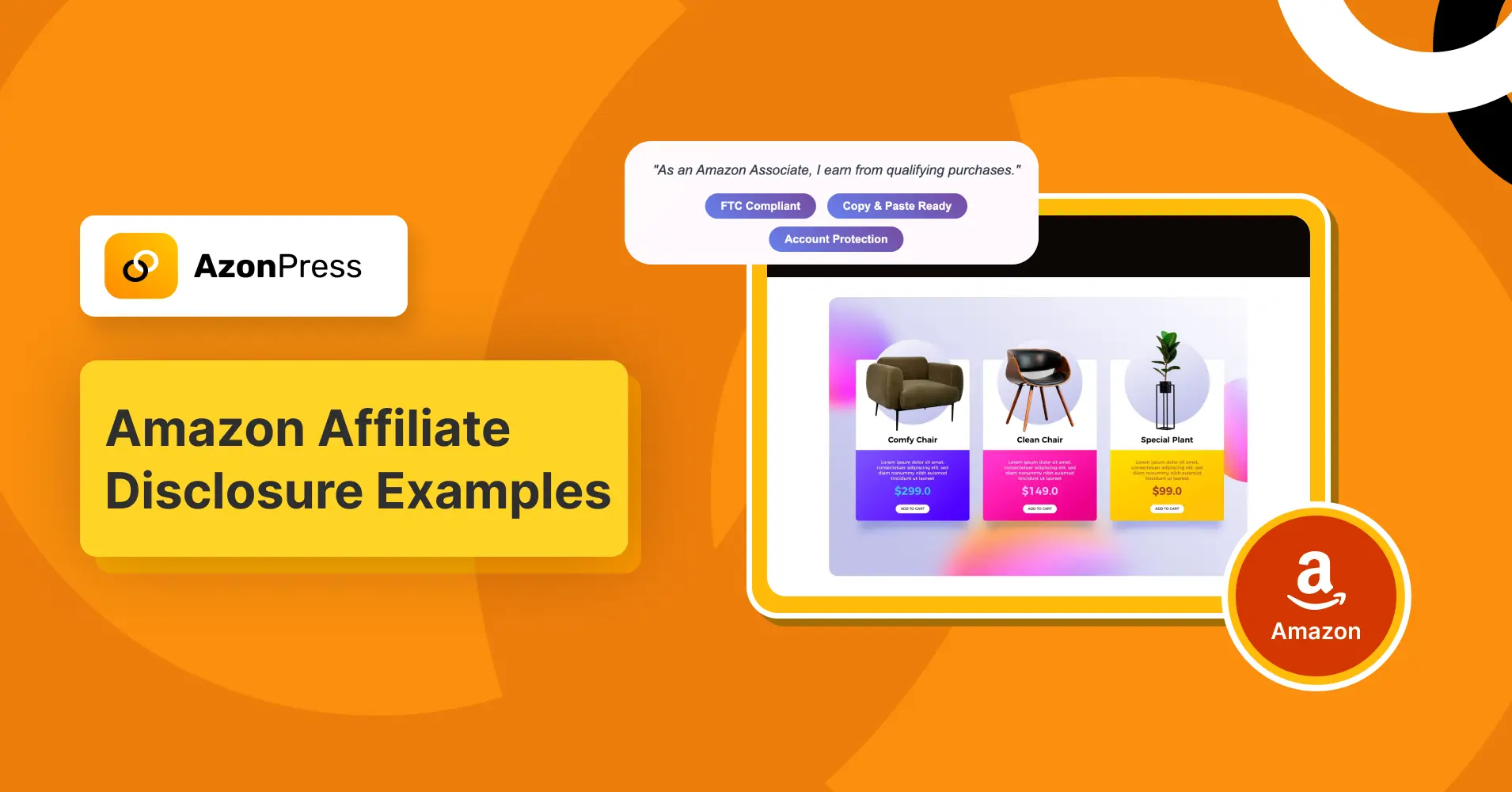
Perfect Amazon Affiliate Disclosure Examples You Can Copy
Popular Posts
Get access to our Exclusive Offers & Pro Tips
TL;DR:
Many Amazon affiliates place their disclosure in the wrong spot, making it ineffective and end up losing accounts. The fix is simple and takes barely 30 seconds. Just add “As an Amazon Associate, I earn from qualifying purchases” in a prominent place that does not violate Amazon and FTC guidelines. This article takes five minutes and gives you proper disclosure examples that can save you from losing years of effort.
Many Amazon affiliates complain about a common issue: they receive emails from Amazon stating that their accounts are at risk or have been banned for violating certain rules.
Joining the Amazon Associates Program isn’t difficult. You can easily become an Amazon affiliate. The most challenging part is maintaining a good standing account. Most affiliates are unaware of the rules and regulations set by Amazon.
And an Amazon affiliate disclosure is one of those rules. It’s a mandatory requirement that you must follow. No exceptions at all!
Not only Amazon, but if you join any other affiliate program, you are also required to include the affiliate link disclosure set by the Federal Trade Commission (FTC).
Starting with the “what” and “why,” this article will give you the perfect Amazon affiliate disclosure examples to help keep your account safe from termination.
What is Amazon affiliate disclosure?
Let me break this down in simple terms. An Amazon affiliate disclosure is basically your way of telling people, “Hey, I make money when you buy stuff through my links.” That’s it. Nothing fancy or complicated.
When I started my affiliate journey three years ago, I thought affiliate link disclosures were just some boring legal stuff that nobody cared about. But was I wrong? Amazon takes this seriously, and so should you.
The disclosure is one of those key requirements that Amazon cares about the most.
It’s a transparency badge that tells your readers you’re not just recommending products out of the goodness of your heart; you’re earning commissions through them.
That clarifies you’re in a paid relationship with Amazon. And people actually appreciate this honesty more than you think.
The Amazon affiliate program disclosure doesn’t have to be a novel. It just needs to be clear enough that anyone can understand it. No tech jargon, no fancy words, just a straight affiliate disclaimer.
Why is it important to add an Amazon affiliate disclosure?
You know your Reddit ID can get restricted for not following their guidelines. Similarly, if you don’t follow the requirements of the Amazon Associate Program, you may end up losing your affiliate account.
Adding disclosures might feel like extra work. But trust me, skipping this step is like driving without a seatbelt. You might be fine for a while, but when something goes wrong, you’re in deep trouble.
Many affiliates learn this lesson the hard way. Reddit forums are filled with posts from confused marketers asking, “How are you disclosing your Amazon Affiliate links? I got this generic reminder message from Amazon.” Don’t let this happen to you.
So, check out the reasons why you should add a disclaimer for affiliate links on your website or social media.
1. Amazon will kick you out without warning
I’ve seen fellow affiliates lose accounts worth thousands of dollars because they ignored the affiliate link disclosure requirements. Amazon doesn’t send you three warnings and a sympathy card.
It keeps you compliant with Amazon’s terms of service. They regularly audit affiliate accounts, and missing disclosures are one of the fastest ways to get your account suspended.
One guy in my Facebook group lost his account after two years of building it up. His monthly commissions? Gone. His years of work? Wasted. All because he thought disclosures were “optional.”
2. FTC Fines Are No Joke
The Federal Trade Commission doesn’t mess around. The FTC requires affiliate marketers to disclose their relationships with companies they promote. This applies to all affiliate programs, not just Amazon.
They’ve handed out fines ranging from $12,000 to $5.7 million for disclosure violations. Yes, you read that right, millions. The FTC disclosure guidelines exist for a reason, and ignoring them can even bankrupt you.
3. Your readers want transparency
Here’s something that might surprise you: people prefer affiliate marketers who disclose their relationships. They dislike the ones who hide them. When you’re upfront about earning commissions, readers trust you more.
After adding proper disclosures, my business started getting better engagement. Because customers appreciate my transparency. This helped my business grow.
If you hide your affiliate relationships with your recommendations, it can damage your reputation and hurt your long-term success.
4. Legal Protection for Your Business
The disclosure also provides legal protection. You can think of your Amazon affiliate link disclosure as insurance. If someone has problems with a product they bought through your link, you can point to your disclosure and say, “I followed all required guidelines.” It’s your legal shield.
5. Better Sleep at Night
Seriously, this is the most important thing. You’re doing affiliate marketing to earn passive income. You don’t want the hassle of Amazon restrictions. All you want is a decent cash flow while dreaming.
Once you get your disclosures right, you stop worrying about those scary Amazon emails. You can focus on creating content instead of wondering if your account will get suspended tomorrow.
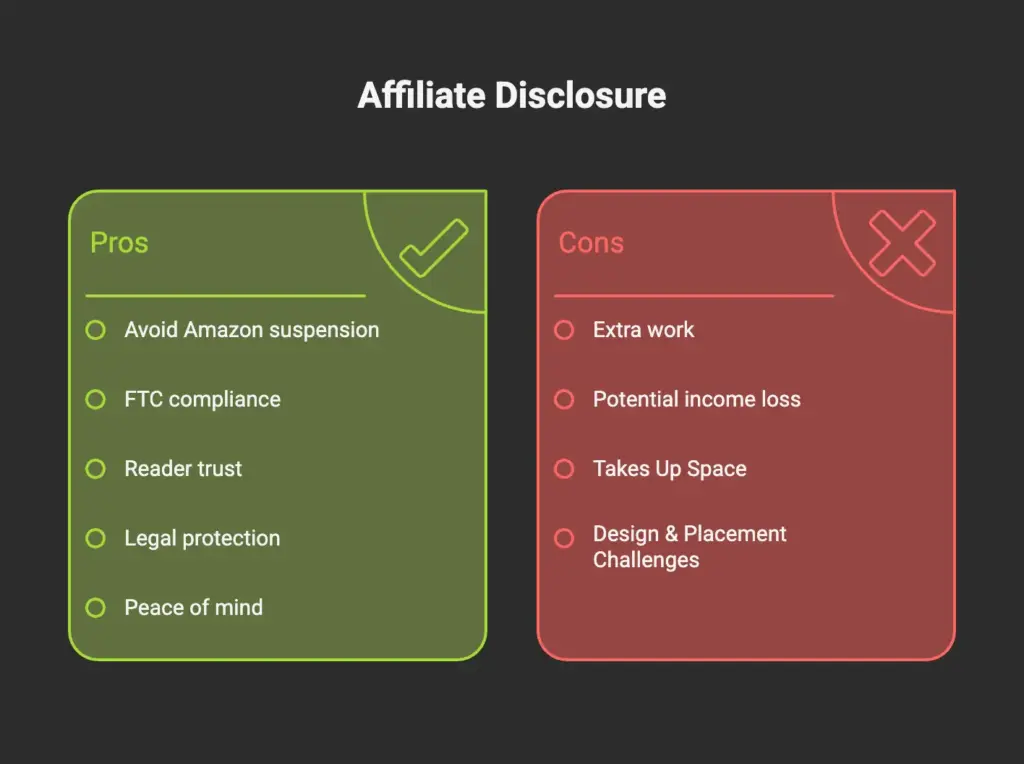
Amazon Affiliate Disclosure Examples
So, now you’ve got an understanding of what an affiliate disclosure is and why it’s so important for doing affiliate marketing smoothly.
Now, let’s get to the good stuff: some proven Amazon affiliate disclosure examples. Here are the exact disclaimers I used and recommend to other affiliates that comply with both Amazon’s requirements and FTC disclosure guidelines.
The classic (Amazon Disclosure Statement)
Your disclosure must be clear and simple, and clearly state the relationship with Amazon. For better understanding, Amazon offers the following disclaimer that you can use:
“As an Amazon Associate, I earn from qualifying purchases.”
or
“[Your name or your website name] participates in the Amazon Services LLC Associates Program, an affiliate advertising program designed to provide a means for sites to earn advertising fees by advertising and linking to Amazon.com.”
These affiliate disclosure examples are Amazon’s suggested template. The first one is the most updated example, whereas the second one was in use until October 2019.
You’re free to use either, as both options comply with Amazon’s disclosure guidelines. But we recommend using the first disclaimer for its simplicity and better user experience.
However, you can use this exact wording on any page with Amazon affiliate links.
The friendly approach
“This post contains affiliate links. As an Amazon Associate, I earn from qualifying purchases. This means I may earn a small commission if you purchase through my links at no extra cost to you.”
This Amazon affiliate disclosure example provides additional context about what affiliate links are and reassures readers that they won’t pay extra for products. Or you can also use this:
“This post may contain affiliate links. If you click one of them, we may receive a cute commission at no extra cost to you. Thank you.”
For a product review website
“This post contains affiliate links, which means as an Amazon Associate, I may earn a small commission if you purchase through my links. There’s no additional cost to you, and I only recommend products I genuinely believe in.”
Or
“We buy all the products we test, no freebies from companies. If you purchase through our links, we may earn a commission.”
If you’re a product reviewer and earn commissions through recommending products, then this is a perfect affiliate link disclosure example that covers multiple affiliate programs while specifically mentioning Amazon.
For Social Media Posts
Average social media users are not very familiar with words like “affiliate,” “affiliate links,” or “associate,” etc. So, according to the FTC disclosure guidelines, you should use #hashtags instead of detailed disclosures.
Hashtags such as #ad, #promotion, #sponsored, #paidlink, etc. can be used in social media to help people understand it’s promotional content right away.
Get access to our exclusive offers and pro tips!
FTC disclosure guidelines
The FTC rules might sound intimidating, but actually they’re pretty straightforward once you understand what they’re asking for.
The main rule is this: your disclosure needs to be impossible to miss. If someone could easily scroll past it or not notice it, you’re doing it wrong.
I remember when I first started, I put my disclosure in tiny gray text at the bottom of my posts. Guess what? That doesn’t work. The FTC affiliate disclosure needs to jump out at people, not hide in the shadows.
They mention multiple times that your affiliate link disclosure should be “clear and conspicuous.”
Here’s what “clear and conspicuous” actually means:
- Make it big enough to read easily
- Use colors that stand out
- Put your Amazon affiliate disclosure in a noticeable place that’s easy to see
- Write it in normal language, no tech jargon
The FTC also wants your disclosure to appear before your affiliate links, not after. Think of it like this: would you want someone to tell you they’re getting paid after you’ve already bought something? Probably not.
For social media, the FTC says to use hashtags like #ad or #affiliate at the beginning of your posts. Don’t bury them in a sea of other hashtags at the end. People need to see them right away.
One thing that surprised me: the FTC doesn’t care if disclosures hurt your conversion rates. They care about protecting consumers. So don’t try to hide your disclosures to get more sales; it’ll backfire eventually.
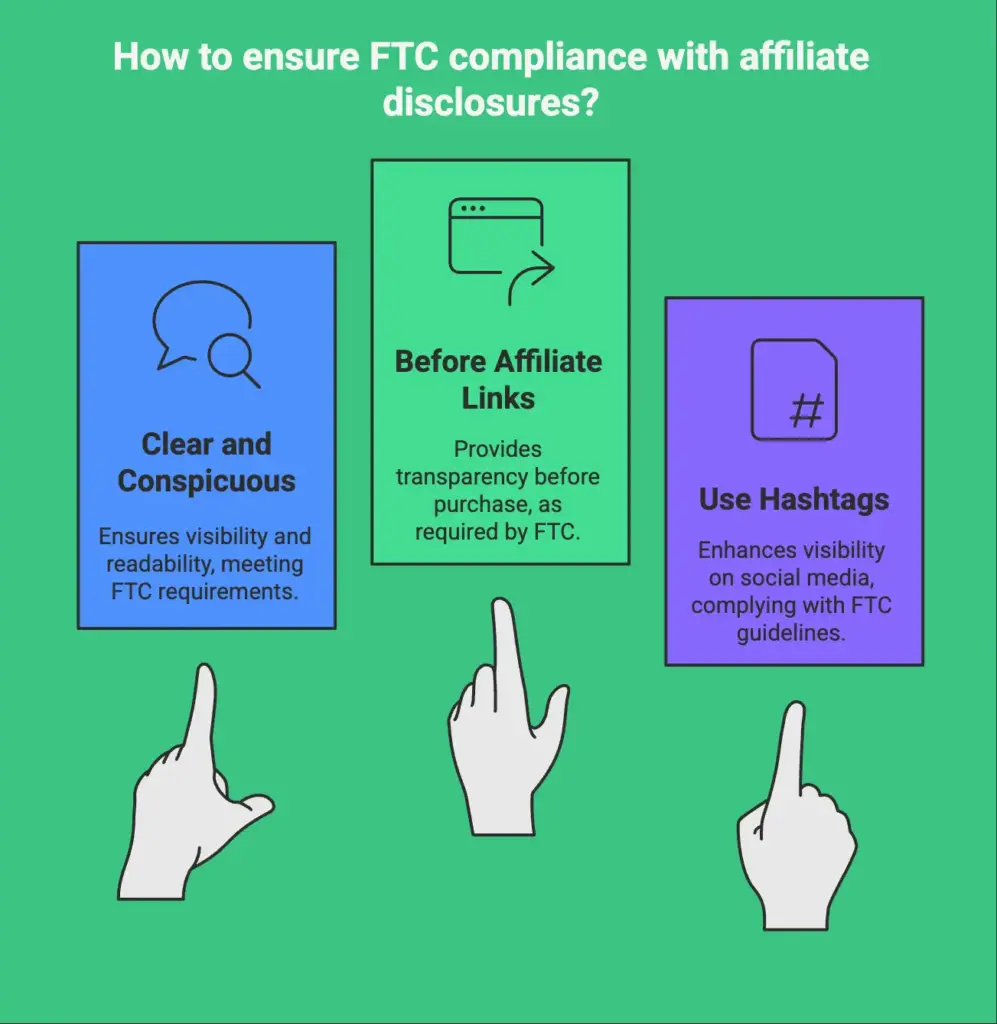
Where to put the Amazon affiliate link disclosure?
Placement is crucial, and this is where most people mess up. They don’t understand where to place the Amazon affiliate link disclosure. But it’s probably the easiest thing to get right.
Top of your content
Place your disclaimer right at the top of every post with affiliate links. You can make it a little colored box to make it stand out. This way, nobody can miss it. It ensures maximum visibility and compliance with both Amazon and FTC requirements.
Before product recommendations
If you’re writing a product review or comparison post, put your affiliate disclaimer right before you start listing products. People need to know you’re earning money before they see your recommendations.
In your sidebar
For websites with sidebars, a clearly visible disclosure widget works well. Make sure it’s positioned where readers will naturally see it.
What not to do
Don’t put your disclosure in your footer. Don’t hide it on a separate “disclosures” page. Don’t make people hunt for it.
These locations don’t meet the “clear and conspicuous” requirement. The Amazon affiliate program disclosure needs to be right there where people can see it.
For product comparison tables or lists, just copy an Amazon affiliate disclosure example and place it immediately above the table or list. This ensures readers see it before engaging with any affiliate links.
Mobile matters too
Test your disclosure on your phone. If it’s hard to read or gets cut off, fix it. People tend to browse on mobile these days, so your disclosure should look good on small screens.
Remember, if you’re using affiliate links in email newsletters, each email should include its own disclosure. Don’t rely on disclosures from your website or previous emails.
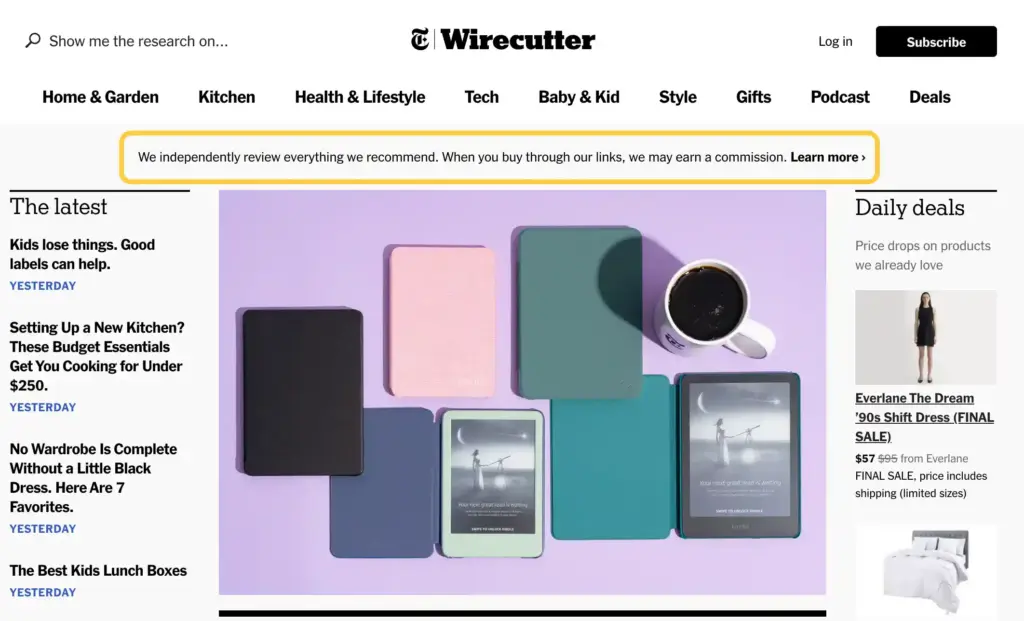
See Wirecutter, a product review website, places the disclosure at the top of every page. They clearly state that they’ll earn a commission if people buy something from their recommendation.
Their statement is clear and placement is perfect, at the top of the content as well as before product recommendations. Which complies with both Amazon and the FTC disclosure guidelines.
Conclusion
Look, I know adding disclosures feels like a pain in the neck. But after seeing friends lose their accounts and dealing with my own close calls, I can tell you it’s worth the effort.
The affiliate link disclosure examples I’ve shared here aren’t just legal requirements; they’re good business practices. They protect you, they build trust with your audience, and they keep Amazon happy.
Don’t wait until you get a scary email from Amazon. Add your disclosures today. Pick one of the examples from this article, customize it to fit your style, and start using it everywhere you have affiliate links.
Read Similar Blogs
We build lasting partnerships to boost and manage revenue growth





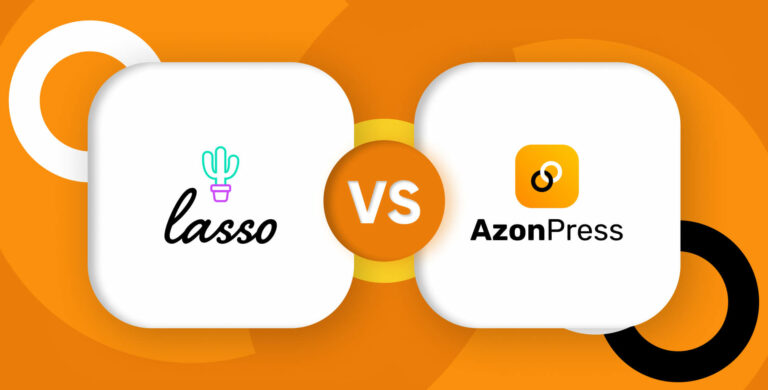
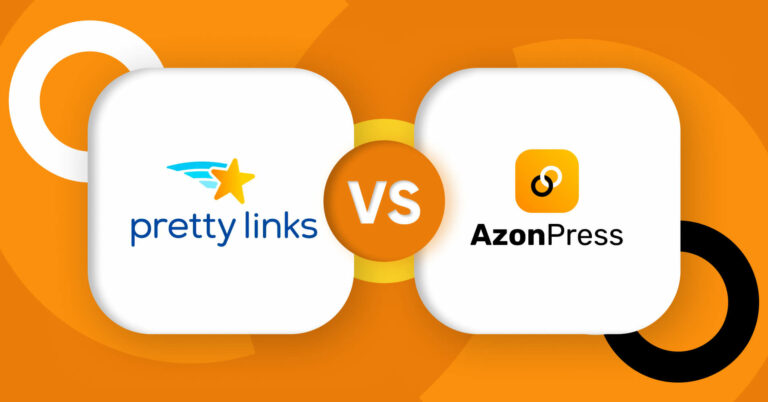
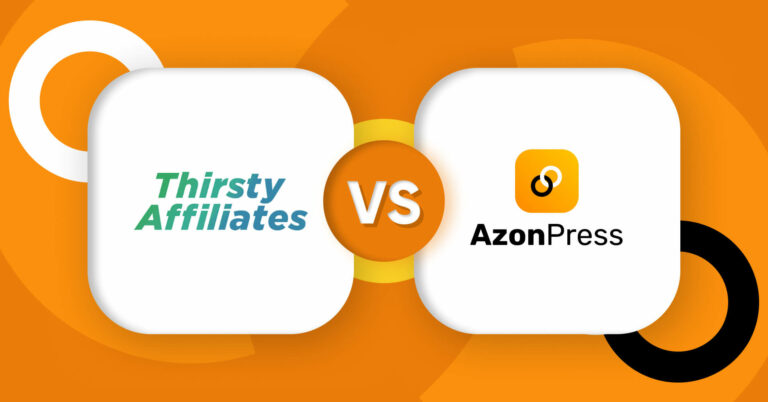





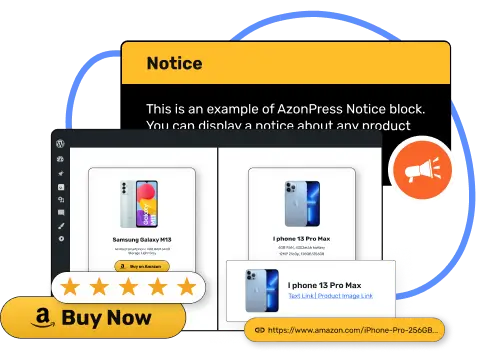







Leave a Reply